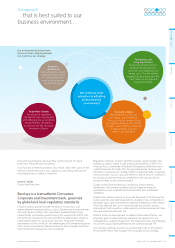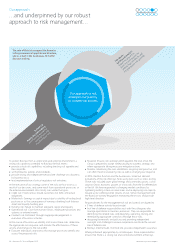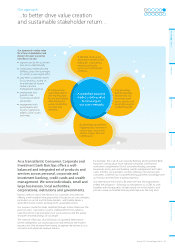Barclays 2015 Annual Report Download - page 18
Download and view the complete annual report
Please find page 18 of the 2015 Barclays annual report below. You can navigate through the pages in the report by either clicking on the pages listed below, or by using the keyword search tool below to find specific information within the annual report.-
 1
1 -
 2
2 -
 3
3 -
 4
4 -
 5
5 -
 6
6 -
 7
7 -
 8
8 -
 9
9 -
 10
10 -
 11
11 -
 12
12 -
 13
13 -
 14
14 -
 15
15 -
 16
16 -
 17
17 -
 18
18 -
 19
19 -
 20
20 -
 21
21 -
 22
22 -
 23
23 -
 24
24 -
 25
25 -
 26
26 -
 27
27 -
 28
28 -
 29
29 -
 30
30 -
 31
31 -
 32
32 -
 33
33 -
 34
34 -
 35
35 -
 36
36 -
 37
37 -
 38
38 -
 39
39 -
 40
40 -
 41
41 -
 42
42 -
 43
43 -
 44
44 -
 45
45 -
 46
46 -
 47
47 -
 48
48 -
 49
49 -
 50
50 -
 51
51 -
 52
52 -
 53
53 -
 54
54 -
 55
55 -
 56
56 -
 57
57 -
 58
58 -
 59
59 -
 60
60 -
 61
61 -
 62
62 -
 63
63 -
 64
64 -
 65
65 -
 66
66 -
 67
67 -
 68
68 -
 69
69 -
 70
70 -
 71
71 -
 72
72 -
 73
73 -
 74
74 -
 75
75 -
 76
76 -
 77
77 -
 78
78 -
 79
79 -
 80
80 -
 81
81 -
 82
82 -
 83
83 -
 84
84 -
 85
85 -
 86
86 -
 87
87 -
 88
88 -
 89
89 -
 90
90 -
 91
91 -
 92
92 -
 93
93 -
 94
94 -
 95
95 -
 96
96 -
 97
97 -
 98
98 -
 99
99 -
 100
100 -
 101
101 -
 102
102 -
 103
103 -
 104
104 -
 105
105 -
 106
106 -
 107
107 -
 108
108 -
 109
109 -
 110
110 -
 111
111 -
 112
112 -
 113
113 -
 114
114 -
 115
115 -
 116
116 -
 117
117 -
 118
118 -
 119
119 -
 120
120 -
 121
121 -
 122
122 -
 123
123 -
 124
124 -
 125
125 -
 126
126 -
 127
127 -
 128
128 -
 129
129 -
 130
130 -
 131
131 -
 132
132 -
 133
133 -
 134
134 -
 135
135 -
 136
136 -
 137
137 -
 138
138 -
 139
139 -
 140
140 -
 141
141 -
 142
142 -
 143
143 -
 144
144 -
 145
145 -
 146
146 -
 147
147 -
 148
148 -
 149
149 -
 150
150 -
 151
151 -
 152
152 -
 153
153 -
 154
154 -
 155
155 -
 156
156 -
 157
157 -
 158
158 -
 159
159 -
 160
160 -
 161
161 -
 162
162 -
 163
163 -
 164
164 -
 165
165 -
 166
166 -
 167
167 -
 168
168 -
 169
169 -
 170
170 -
 171
171 -
 172
172 -
 173
173 -
 174
174 -
 175
175 -
 176
176 -
 177
177 -
 178
178 -
 179
179 -
 180
180 -
 181
181 -
 182
182 -
 183
183 -
 184
184 -
 185
185 -
 186
186 -
 187
187 -
 188
188 -
 189
189 -
 190
190 -
 191
191 -
 192
192 -
 193
193 -
 194
194 -
 195
195 -
 196
196 -
 197
197 -
 198
198 -
 199
199 -
 200
200 -
 201
201 -
 202
202 -
 203
203 -
 204
204 -
 205
205 -
 206
206 -
 207
207 -
 208
208 -
 209
209 -
 210
210 -
 211
211 -
 212
212 -
 213
213 -
 214
214 -
 215
215 -
 216
216 -
 217
217 -
 218
218 -
 219
219 -
 220
220 -
 221
221 -
 222
222 -
 223
223 -
 224
224 -
 225
225 -
 226
226 -
 227
227 -
 228
228 -
 229
229 -
 230
230 -
 231
231 -
 232
232 -
 233
233 -
 234
234 -
 235
235 -
 236
236 -
 237
237 -
 238
238 -
 239
239 -
 240
240 -
 241
241 -
 242
242 -
 243
243 -
 244
244 -
 245
245 -
 246
246 -
 247
247 -
 248
248 -
 249
249 -
 250
250 -
 251
251 -
 252
252 -
 253
253 -
 254
254 -
 255
255 -
 256
256 -
 257
257 -
 258
258 -
 259
259 -
 260
260 -
 261
261 -
 262
262 -
 263
263 -
 264
264 -
 265
265 -
 266
266 -
 267
267 -
 268
268 -
 269
269 -
 270
270 -
 271
271 -
 272
272 -
 273
273 -
 274
274 -
 275
275 -
 276
276 -
 277
277 -
 278
278 -
 279
279 -
 280
280 -
 281
281 -
 282
282 -
 283
283 -
 284
284 -
 285
285 -
 286
286 -
 287
287 -
 288
288 -
 289
289 -
 290
290 -
 291
291 -
 292
292 -
 293
293 -
 294
294 -
 295
295 -
 296
296 -
 297
297 -
 298
298 -
 299
299 -
 300
300 -
 301
301 -
 302
302 -
 303
303 -
 304
304 -
 305
305 -
 306
306 -
 307
307 -
 308
308 -
 309
309 -
 310
310 -
 311
311 -
 312
312 -
 313
313 -
 314
314 -
 315
315 -
 316
316 -
 317
317 -
 318
318 -
 319
319 -
 320
320 -
 321
321 -
 322
322 -
 323
323 -
 324
324 -
 325
325 -
 326
326 -
 327
327 -
 328
328 -
 329
329 -
 330
330 -
 331
331 -
 332
332 -
 333
333 -
 334
334 -
 335
335 -
 336
336 -
 337
337 -
 338
338 -
 339
339 -
 340
340 -
 341
341 -
 342
342 -
 343
343 -
 344
344 -
 345
345 -
 346
346 -
 347
347 -
 348
348 -
 349
349 -
 350
350 -
 351
351 -
 352
352 -
 353
353 -
 354
354 -
 355
355 -
 356
356
 |
 |

16 I Barclays PLC Annual Report 2015 home.barclays/annualreport
How we are doing
…effectively managing risk to create
sustainable returns for our Company.
What we are doing
We are committed to delivering long-term acceptable returns to
shareholders in a sustainable way, while maintaining adequate levels
of capital to enable the Bank to operate safely through challenging
economic conditions.
We will achieve this by prudently optimising the level, mix and
distribution to businesses of our capital resources whilst maintaining
sufficient capital resources in order to:
ensure the Group is well capitalised relative to its minimum
regulatory capital requirements set by the PRA and other
regulatory authorities
support its credit rating
support its growth and strategic objectives.
Balanced Scorecard metric
Actual
2015
Actual
2014
Actual
2013 a
Fully loaded CRD IV CET1 ratio 11.4% 10.3% 9.1%
Return on Equity (Adjusted) 4.9% 5.1% 4.3%
Note
a 2013 Return on Equity (Adjusted) has been revised to account for
the reclassification of £173m of charges, relating to a US residential
mortgage related business settlement with the Federal Housing
Finance Agency, to provisions for ongoing investigations and
litigation including Foreign Exchange to aid comparability.
How we measure success
Fully Loaded CRD IV CET1 ratio
The Fully loaded CRD IV CET1 ratio demonstrates the
capital strength and resilience of Barclays. By ensuring
we are well capitalised relative to minimum capital
requirements of regulatory authorities, we create a
safer bank for customers and clients, and all
stakeholders through challenging economic conditions.
The ratio expresses Barclays’ capital as a percentage of
risk weighted assets (RWAs), as defined by the PRA, in
the context of CRD IV (an EU Directive prescribing
capital adequacy and liquidity requirements), and is
part of the regulatory framework governing how banks
and depository institutions are supervised.
Adjusted Return on Equity (RoE)
Adjusted RoE measures the organisation’s ability to
generate acceptable returns for shareholders.
Adjusted RoE is calculated as adjusted profit for the
year attributable to ordinary equity holders of the
parent divided by average shareholders’ equity for the
year excluding non-controlling and other equity
interests. It excludes certain items, including those that
are significant but not representative of the underlying
business performance.
How we are doing
Fully loaded CRD IV CET1 ratio
In 2015 the Group’s CET1 ratio increased by 110 basis points to 11.4%.
The main driver was a £44bn reduction in RWAs to £358bn,
demonstrating continued progress on the Non-Core rundown together
with reductions in the Investment Bank. This was partially offset by a
decrease in CET1 capital to £40.7bn (2014: £41.5bn). We will continue
to reduce RWAs within Non-Core, while looking to allocate capital to RoE
enhancing growth opportunities in our Core businesses.
Adjusted Return on Equity
Adjusted RoE in 2015 decreased to 4.9% (2015: 5.1%) as adjusted PBT
fell by 2% to £5,403m, driven by a 24% increase in the Non-Core loss
before tax to £1,459m as a result of the continued rundown, partially
offset by a 3% increase in Core profit before tax to £6,862m. Adjusted
RoE for Core was 9.0% (2014: 9.2%).
The Group estimates its cost of equity for 2016 at 10.5%.
STAKEHOLDER PERFORMANCE
Case study
Our Non-Core division is responsible for the divestment of Barclays
non-strategic assets and businesses, and is run by a dedicated
management team operating within a clear governance framework
to rundown the unit while optimising shareholder value.
When the Non-Core division was created in May 2014, RWAs were
£110bn. By the end of 2015, this had reduced to £47bn as a result
of the disposal of Businesses, the rundown and exit of Securities
and Loans, and Derivative risk reductions. Key drivers of the decrease
in RWAs of £29bn in 2015 were a £10bn reduction in the Derivative
portfolio, £9bn reduction in Securities and Loans, and reductions
as a result of the sale of the Spanish and UK Secured Lending
businesses. The announced sale of the Portuguese and Italian retail
businesses in H215, due to be completed in H116, are expected to
result in a further £2.5bn reduction in Non-Core RWAs.
